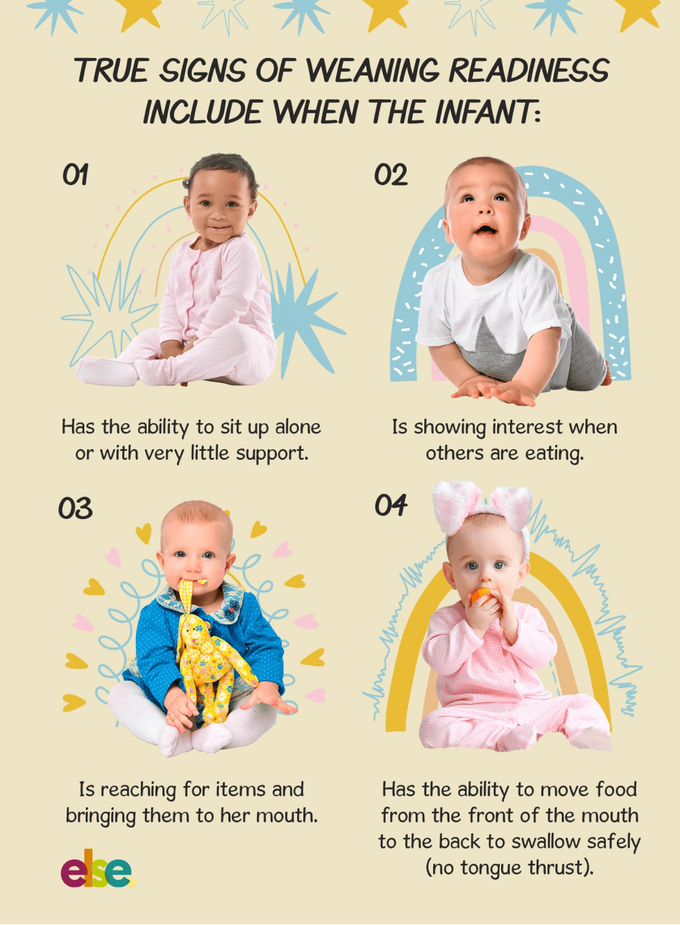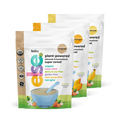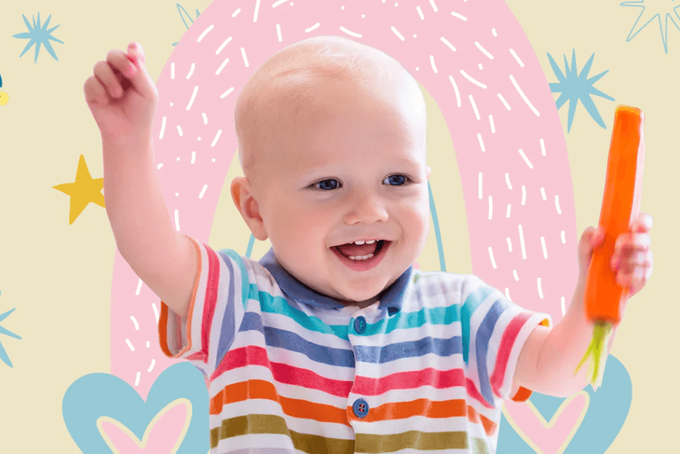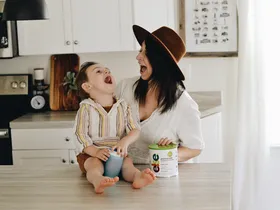A Comprehensive Guide to Baby-Led Weaning
Perhaps one of the most exciting milestones in a baby’s life is when they begin to wean to solid foods. Learn when your baby is ready, as well as tips to wean them safely.
Published June 12, 2024

Perhaps one of the most exciting milestones in a baby’s life is when they begin to wean to solid foods. Not to be confused with weaning from breastfeeding to formula, weaning to solids is the very gradual transition from nursing to enjoying the foods that the rest of the family eats.
» Still breastfeeding? Here's how to transition baby to formula
The World Health Organization (WHO) suggests that weaning should begin around six months of age. True signs of readiness include when the infant:
- Has the ability to sit up alone or with very little support.
- Is showing interest when others are eating.
- Is reaching for items and bringing them to her mouth.
- Has the ability to move food from the front of the mouth to the back to swallow safely (no tongue thrust).
When your baby demonstrates these signals, you are ready to start solids!
Baby-Led Weaning Defined
Traditionally in the United States, the first foods introduced to babies are very thin purees, either store-purchased jars or homemade, which are introduced with a spoon. This method gives caregivers control over how much the baby eats, sometimes encouraging the baby to take more food than is needed by making the process entertaining (e.g. pretending the spoon is an airplane coming into baby’s mouth for a landing).
More recently, there has been a movement toward baby-led weaning in which the child has control over how much to eat. Caregivers place easy-to-grasp strips of very soft food on the tray in front of the baby, and the baby picks the food up with her hands and self-feeds. Some research suggests that allowing infants to control how much is consumed results in healthier weight, growth, and developmental outcomes.
There is growing evidence supporting the benefits of baby-led weaning, but there are still some concerns regarding this method. Here are the main concerns vs. the benefits:
The Concerns
- Baby-led weaning may not support sufficient iron-dense food intake.
- There may be a higher risk of choking using this method.
- Busy parents may be tempted to leave the baby alone with food, leading to missed social interaction and increased choking risks.
- Unnecessary sugar and salt may be added to family foods, which is not optimal for babies.
The Possible Benefits
- Self-feeding promotes fine motor skills and an early understanding of textures, allowing the baby to learn how to get the foods from the tray to the mouth.
- Baby is gaining independence and confidence in her own abilities.
- Family foods and flavors become normal for your child.
- Baby is in control of how much she wants to eat, and overfeeding is avoided.
How to Start Baby-Led Weaning: Tips and Tricks
If you are interested in trying baby-led weaning, it is important not to start too soon. Begin the process around six months of age, when your infant is showing the readiness signs listed above.
» Learn the signs that indicate your baby is ready to start solid foods
If your family is not already eating together at mealtime, this is a great time to start. Babies thrive on social interaction and will learn how to eat by watching their parents.
Now is also the time to get the whole family eating healthier. A main premise for baby-led weaning is to get your infant used to what the family eats, and optimal brain and body development depend on nutrient-dense foods. Let your baby be the motivator to cook healthier meals.
» Discover what constitutes complete nutrition for babies and how to ensure your family eats nutrient-dense foods
Breastmilk or formula will still be the primary sources of nutrients for a while, until the baby turns 1 or older. It may be helpful to nurse the baby shortly before putting her in the highchair so she’s not uncomfortably hungry.
Be sure to seat the baby in a highchair or feeding seat so that the caregiver is facing the baby and able to watch carefully. Never leave the baby alone when eating.
The baby should self-feed mostly with his or her fists at first. Cut the food into strips that are easiest to grasp, about the size and length of half a finger. First foods should be easy to mash by baby’s gums. Test the texture of the food by gently pressing between your lips, or between your fingers.
» Learn more about when to introduce finger foods to babies
Do offer baby an infant-appropriate plastic spoon to hold. While a baby spoon will be used as a teething toy or a drumstick in the beginning, your child will learn to use it with practice.
Finally, expect a mess! The food will seem to get everywhere except into the baby's belly at first, but that’s all part of the healthy learning process. Let the baby have fun with food! Don’t stress about how much they are eating, exploration is important.
What Foods to Offer: Great Starter Foods
High-iron foods
- Scrambled or hard-boiled eggs, cut into strips
- Very tenderly cooked ground beef stew meat
- Very tenderly cooked or stewed poultry
- Tofu chunks
- Black beans, slightly mashed
Foods high in vitamin C
Try very ripe or softly cooked:
- Broccoli
- Bell Peppers
- Tomatoes
- Strawberries
- Oranges
- Kiwis
- Mangos
- Papayas
High Energy Foods
- Ripe avocados
- Skinless, softly cooked sweet potato wedges
- Plain whole-fat Greek yogurt
- Harder cheeses like cheddar
- Nut butter thinly spread on toast strips
- Chia pudding
» Looking for ideas for feeding your baby? Check out our Else recipes for plenty of baby and toddler-friendly ideas
Regarding Allergies and Foods to Avoid Until at Least One Year
You may be aware that the rules for introducing high-allergy foods like eggs and nuts have changed. Allergists used to believe that avoiding these foods during the first year would reduce the risk of food allergies in kids; now they believe the opposite is true. Before weaning begins, discuss your child’s food allergy risks with her pediatrician.
» Take caution, and explore how to safely introduce allergens to your little one
The foods below should not be offered to an infant before one year of age and should be avoided when trying baby-led weaning as well:
- Honey because of its potential for c. botulinum contamination
- Liquid cow’s milk because infants still need to drink breastmilk or formula
- Lunch meats and soft cheese may be contaminated with l. monocytogenes
Baby-led weaning does not have to be all or nothing, and you may enjoy offering spoon-fed pureed foods when convenience is needed or if you or your doctor are concerned about your infant’s nutrient intake.
Remember to relax and try to have fun! There certainly isn’t only one right way to feed your infant.
The content and advice provided in this article is for informational purposes only and is not a substitute for medical diagnosis, treatment, advice for specific medical conditions. Always consult a pediatrician to understand the individual needs of your child.











